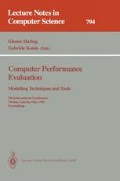Abstract
This paper describes the PAPS parallel program performance prediction toolset which is currently based on an initial set of Petri net driven performance prediction tools. Flexibility, extendability and automation were the general goals in the design of the toolset. Parallel systems are described by acyclic task graphs representing typical workloads of parallel programs, by processor graphs describing MIMD distributed memory multiprocessor hardware, and a mapping function. The three specifications, program, resource and mapping, are separated to be able to change them independently from each other. Methods to make this separation feasible are described. The PAPS toolset is logically divided into four layers: The specification layer, containing tools for writing scalable, mapping independent specifications, the transformation layer, consisting of tools which generate performance models, the evaluation layer, that contains performance analysis tools, and the presentation layer, which consists of tools for the visualization and depiction of performance evaluation results.
This work was funded by the Austrian Science Foundation (research grant S5303-PHY).
Preview
Unable to display preview. Download preview PDF.
References
Martin Althaus and Michael Ortlepp. Das Excel 4 Buch. SYBEX-Verlag GmbH, Düsseldorf, 1992.
Craig M. Chase, Alex L. Cheung, Anthony P. Reeves, and Mark R. Smith. Paragon: A parallel programming environment for scientific applications using communication structures. Journal of Parallel and Distributed Computing, 16:79–91, 1992.
G. Chiola. Greatspn1.5 software architecture. In Proc. of the 5th Int. Conf. on Modelling Techniques and Tools for Computer Performance Evaluation. Torino, Italy, Feb. 13–15, 1991, pages 117–132, 1991.
A. Ferscha. A petri net approach for performance oriented parallel program design. Journal of Parallel and Distributed Computing, (15):188–206, 1992.
A. Ferscha and G. Haring. On performance oriented environments for the development of parallel programs. Kybernetika a Informatika, Proceedings of the 15th Symposium on Cybernetics and Informatics '91, April 3–5 1991, Smolenice Castle, ČSFR, 4(1/2), 1991.
Alois Ferscha. Modellierung und leistungsanalyse paralleler systeme mit dem prm-netz modell. Ph.D. Thesis, University of Vienna. To be published in OCG-Schriftenreihe, Oldenbourg Verlag, 65, 1990.
G. A. Geist, M. T. Heath, B. W. Peyton, and P. H. Worley. Picl: A portable instrumented communication library. Technical Report ORNL/TM-11130, Oak Ridge National Laboratory, July 1990.
G. A. Geist, M. T. Heath, B. W. Peyton, and P. H. Worley. A users' guide to picl: a portable instrumented communication library. Technical Report ORNL/TM-11616, Oak Ridge National Laboratory, August 1990.
Erol Gelenbe. Multiprocessor Performance, Series in Parallel Computing. John Wiley & Sons Ltd., 1989.
Leana Golubchik, Gary D. Rozenblat, William C. Cheng, and Richard R. Muntz. The tangram modeling environment. In Proc. of the 5th Int. Conf. on Modelling Techniques and Tools for Computer Performance Evaluation. Torino, Italy, Feb. 13–15, 1991, pages 421–435, 1991.
V.A. Guarna Jr., D. Gannon, D. Jablonowski, A.D. Mallony, and Y. Gaur. Faust: An integrated environment for parallel programming. IEEE Software, 6(4), 1989.
Michael T. Heath and Jennifer A. Etheridge. Visualizing performance of parallel programs. Technical Report ORNL/TM-11813, Oak Ridge National Laboratory, May 1991.
Michael T. Heath and Jennifer A. Etheridge. Visualizing the performance of parallel programs. IEEE Software, 8(5):29–39, September 1991.
M. Molloy. Performance modeling using stochastic petri nets. IEEE Trans. Comput., C-31:913–917, September 1982.
T. Murata. Petri nets: Properties, analysis and applications. Proceedings of the IEEE, 77(4):541–580, April 1989.
nCUBE. nCUBE & Programmer's Guide. nCUBE Corporation, 1990.
K. Nichols. Performance tools. IEEE Software, 7(3):21–30, May 1990.
OACIS. Parallel programming support environment research. Technical Report TR-PPSE-89-1, Oregon Advanced Computing Institute, 1989.
P. Oman. Case analysis and design tools. IEEE Software, 7(3):37–43, May 1990.
P. Oman. Tools for multiple cpu environments. IEEE Software, 7(3):45–51, May 1990.
C. A. Petri. Kommunikation mit automaten. Bonn: Institut für Instrumentelle Mathematik, Schriften des IIM, (3), 1962.
C. A. Petri. Communication with automata. Technical Report RADC-TR-65-377, vol.1, Suppl. 1, New York: Griffiss Air Force Base, 1966.
R. J. Pooley. The integrated modelling support environment, a new generation of performance modelling tools. In Proc. of the 5th Int. Conf. on Modelling Techniques and Tools for Computer Performance Evaluation. Torino, Italy, Feb. 13–15, 1991, pages 1–15, 1991.
Z. Segall and L. Rudolph. Pie: A programming and instrumentation environment for parallel programming. IEEE Software, 2:22–37, November 1985.
J. Sifakis. Petri nets for performance evaluation. In Measuring, Modeling, and Evaluating Computer Systems, pages 75–93. H. Beilner and E. Gelenbe, Eds. North-Holland, 1977.
L. Snyder and D. Socha. Poker on the cosmic cube: The first retargetable parallel programming language and environment. In K. Hwang, S.M. Jacobs, E.E. Swartzlander (Editor): Proceedings of Int'l Conf. on Parallel Processing, IEEE Computer Society Press, Washington D.C., pages 628–635, August 1986.
H. Wabnig and G. Haring. Performance prediction of parallel systems with scalable specifications — methodology and case study (extended abstract). Accepted as Poster at the 1994 ACM SIGMETRICS Conference on Measurement and Modeling of Computer Systems, 16–20 May 1994, Nashville, USA, 1994.
H. Wabnig and G. Haring. Petri net performance models of parallel systems — methodology and case study. Submitted to PARLE'94 — Parallel Architectures and Languages Europe, 13–17 June 1994, Athens, Greece, 1994.
H. Wabnig, G. Kotsis, and G. Haring. Performance prediction of parallel programs. In Proc. of the 7th GI/ITG Conference on Measurement, Modelling and Performance Evaluation of Computer Systems, 21–23 September 1993, Aachen, Germany, pages 64–76. Springer Verlag, New York, 1993.
Author information
Authors and Affiliations
Editor information
Rights and permissions
Copyright information
© 1994 Springer-Verlag Berlin Heidelberg
About this paper
Cite this paper
Wabnig, H., Haring, G. (1994). PAPS — The parallel program performance prediction toolset. In: Haring, G., Kotsis, G. (eds) Computer Performance Evaluation Modelling Techniques and Tools. TOOLS 1994. Lecture Notes in Computer Science, vol 794. Springer, Berlin, Heidelberg. https://doi.org/10.1007/3-540-58021-2_16
Download citation
DOI: https://doi.org/10.1007/3-540-58021-2_16
Published:
Publisher Name: Springer, Berlin, Heidelberg
Print ISBN: 978-3-540-58021-8
Online ISBN: 978-3-540-48416-5
eBook Packages: Springer Book Archive

